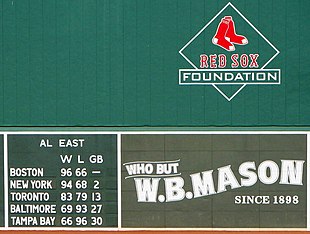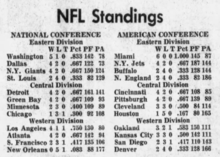
In some North American sports, the phrase games behind or games back (often abbreviated GB) refers to a common way to reflect the gap between a leading team and another team in a sports league, conference, or division.

In some North American sports, the phrase games behind or games back (often abbreviated GB) refers to a common way to reflect the gap between a leading team and another team in a sports league, conference, or division.
In the standings below from the 1994 Major League Baseball season, the Atlanta Braves are six games behind the Montreal Expos. Atlanta would have to win six games, and Montreal would have to lose six games, to tie for first. The leading team is by definition zero games behind itself, and this is indicated in the standings with a dash, not a zero.
|
Games behind is calculated by using either of the following formulas, in which Team A is a leading team, and Team B is a trailing team. Example math in this section uses the above standings, with Montreal as Team A and Atlanta as Team B.
Alternately:
Notes:
A games behind calculation can be misleading when attempting to compare teams that have played an unequal number of games. This is because the games behind calculation simply computes the difference between wins and losses for each team, and then averages those two numbers. Essentially, this treats each unplayed game as being a tie (i.e. 1⁄2 win and a 1⁄2 loss).
In reality, teams in an actual sports league can have an unequal number of games played due to various scheduling anomalies, postponements, or cancellations. This can result in:
Such conditions have occurred multiple times in major sports leagues, examples include:
| Date | League and Division |
Teams | W–L | Win Pct. | GB | Ref. |
|---|---|---|---|---|---|---|
| June 11, 1901 | NL | New York Giants | 19–14 | .576 | 1⁄2 | [5] |
| Pittsburgh Pirates | 23–17 | .575 | — | |||
| April 22, 1913 | NL | Philadelphia Phillies | 4–1 | .800 | 1 | [6] |
| Pittsburgh Pirates | 7–2 | .778 | — | |||
| May 27, 1940 | NL | Brooklyn Dodgers | 20–8 | .714 | 1⁄2 | [7] |
| Cincinnati Reds | 22–9 | .710 | — | |||
| April 27, 1972 | AL West | Minnesota Twins | 5–2 | .714 | 1⁄2 | [8] |
| Chicago White Sox | 7–3 | .700 | — | |||
| April 13, 1983 | NL East | St. Louis Cardinals | 3–1 | .750 | 1⁄2 | [9] |
| Pittsburgh Pirates | 5–2 | .714 | — | |||
| April 24, 1983 | AL West | Kansas City Royals | 8–5 | .615 | 1⁄2 | [10] |
| California Angels | 11–7 | .611 | — | |||
| May 15, 1992 | AL East | Baltimore Orioles | 23–11 | .6765 | 1⁄2 | [11] |
| Toronto Blue Jays | 25–12 | .6757 | — | |||
| May 17, 2018 | AL East | New York Yankees | 28–13 | .683 | 1⁄2 | [12] |
| Boston Red Sox | 30–14 | .682 | — | |||
| August 24, 2020 | AL East | New York Yankees | 16–9 | .640 | 1⁄2 | [13] |
| Tampa Bay Rays | 19–11 | .633 | — |
There are likely many other examples of this in MLB history.
| Date | Conference or Division |
Teams | W–L | Win Pct. | GB | Ref. |
|---|---|---|---|---|---|---|
| December 20, 1949 | Central Division | Rochester Royals | 14–8 | .636 | 1⁄2 | [14] |
| Chicago Stags | 17–10 | .630 | — | |||
| December 28, 1983 | Pacific Division | Los Angeles Lakers | 19–9 | .679 | 1⁄2 | [15] |
| Portland Trail Blazers | 21–10 | .677 | — | |||
| December 28, 2018 | Eastern Conference | Milwaukee Bucks | 24–10 | .706 | 1⁄2 | [16] |
| Toronto Raptors | 26–11 | .703 | — | |||
| December 27, 2023 | Western Conference | Oklahoma City Thunder | 20–9 | .690 | 1⁄2 | [17] |
| Denver Nuggets | 22–10 | .688 | — | |||
| January 4, 2024 | Western Conference | Oklahoma City Thunder | 23–10 | .697 | 1⁄2 | [18] |
| Denver Nuggets | 25–11 | .694 | — | |||
| January 28, 2024 | Western Conference | Los Angeles Clippers | 30–14 | .682 | 1⁄2 | [19] |
| Denver Nuggets | 32–15 | .681 | — |
There are likely many other examples of this in NBA history.
Leagues generally use winning percentage to order teams in official standings. However, standings appearing in newspapers or online may order teams based on games behind.

The games behind calculation is often used in professional baseball and basketball, where tie games are not permitted.[a] Standings for these sports appearing in print or online during a season usually will have teams ordered by winning percentages, with a "GB" column provided as a convenience to the reader. Games behind is used less often in American football, where ties are possible but relatively uncommon. Games behind is rarely used in ice hockey and soccer, where ties are or were traditionally common and standings points are typically used.
Major League Baseball (MLB) defines games behind as "the average of the differences between the leading team wins and the trailing team wins, and the leading teams losses and the trailing team losses."[21] A games behind column almost always appears in MLB standings for each five-team division.
In the 1994 MLB season, the American League and National League each split into three divisions, and each added a wild card team to the playoffs. Following this change, it became common for the media to publish an additional set of standings for the wild card race. It included all teams from a league, with the exception of the division leaders, and games behind was calculated with respect to the team with the highest standing in the wild card race.
In the 2012 MLB season, both leagues added a second wild card team, and a third wild card team was added for each league starting with the 2022 MLB season. Games behind in the wild card race is now calculated with respect to the final wild card position. MLB's website distinguishes this statistic as wild card games behind, abbreviated WCGB.[22] Unless all wild card qualifying teams are tied, this results in some teams being shown as some number of "games ahead" of the final qualifier, indicated by a plus sign ("+") in the standings. For example, see the 2012 NL Wild Card standings, which shows the Atlanta Braves six games ahead of the St. Louis Cardinals, and the 2022 AL Wild Card standings, which shows the Toronto Blue Jays and Seattle Mariners six games and four games, respectively, ahead of the Tampa Bay Rays.
National Basketball Association (NBA) standings typically report games behind within each five-team division. However, it is not as closely followed as in baseball, because more teams qualify for the NBA playoffs, and the divisional statistics are not as important for playoff qualification. Sometimes, especially nearing the end of the regular season, games behind will be given with respect to the sixth through tenth positions in the Eastern Conference and Western Conference, due to the significance of the seeds in relation with the NBA’s play-in tournament.

National Football League (NFL) standings sometimes report games behind, although the statistic is not emphasized; winning percentage is used, computed from each team's win–loss–tie record. This is especially true since the introduction of the bye week in 1990, exacerbating differences in the number of games that teams have played at various points in time, in addition to the possibility of tied games, which while highly uncommon since the introduction of overtime in the regular season starting in 1974 do still occur on occasion. Games behind is omitted from standings on the NFL's website[23] and is absent from most published standings.
The games behind statistic is eschewed in sports where tie games are traditionally common, such as ice hockey and soccer. Leagues in these sports typically rank teams by awarding a certain number of points for each win or tie. In competitions where ties have been abolished (especially in hockey), points are still awarded for an "overtime loss" such that they are often (but not always) the same value as ties previously were, while in soccer the traditional value of two points for a win has been replaced by three points, while ties are still worth one point. These changes would make calculating a "games behind" statistic even more complicated compared to if it were to be used under the traditional system in which a tie was effectively worth a "half-win."
The Canadian Football League (CFL) also does not use games behind, and awards standings points.[24] However, unlike leagues such as the National Hockey League (NHL), the CFL does not award points for overtime losses, although it experimented with such a system in the early 21st century. Also, unlike most other football codes that award three points for a win, the CFL still uses the traditional values of two points for a win and one for a tie. Therefore, a tie in the CFL is still effectively worth a "half-win" as it always has been in Canadian football (and also as it has been in the NFL since 1972).
Teams are sometimes referred to as being over or under "five hundred", in comparison to a winning percentage of .500 (percentage being a misnomer in the usual North American expression; .500 meaning 50% in this context). The calculation for this is simple subtraction. For example, a team at 29–19 is "10 games over five hundred",[25] as they could lose their next 10 games and still have a .500 record, while a team at 12–17 would be "five games under five hundred",[26] as the quickest they could reach .500 would be by winning their next five games. "Above" and "below" can be substituted for "over" and "under", respectively.